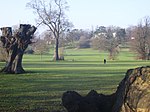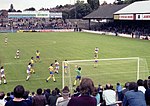Blessed Hugh Faringdon Catholic School
Catholic secondary schools in the Diocese of PortsmouthSecondary schools in Reading, BerkshireUse British English from February 2023Voluntary aided schools in England
Blessed Hugh Faringdon is a Catholic state secondary school in Reading in Berkshire, England. The school has approximately 850 pupils on roll and around 100 teaching and non teaching staff. The school specialises in Mathematics and the Performing Arts. Blessed Hugh Faringdon is one of the many Catholic schools in and around Reading but the only secondary and is under the Trusteeship of the Diocese of Portsmouth. The school is a member of the Partners in Excellence group of schools.
Excerpt from the Wikipedia article Blessed Hugh Faringdon Catholic School (License: CC BY-SA 3.0, Authors).Blessed Hugh Faringdon Catholic School
Fawley Road, Reading Southcote
Geographical coordinates (GPS) Address Phone number Website Nearby Places Show on map
Geographical coordinates (GPS)
| Latitude | Longitude |
|---|---|
| N 51.445 ° | E -1.004 ° |
Address
Blessed Hugh Faringdon Catholic School
Fawley Road
RG30 3EP Reading, Southcote
England, United Kingdom
Open on Google Maps







